Introduction
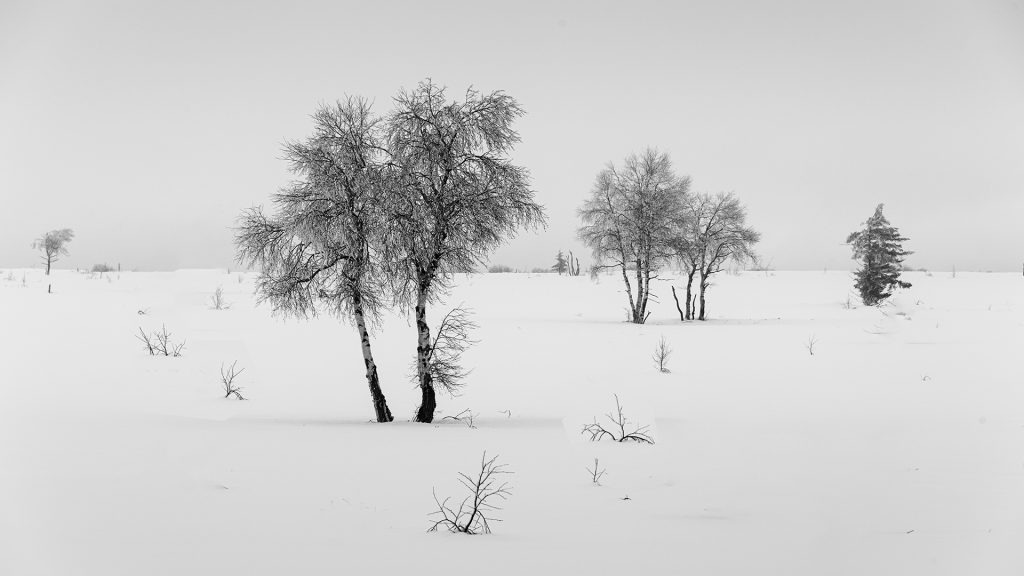
The cold and darker conditions might seduce you to stay inside close to the fireplace. But it would be a pity to store your camera just because summer and autumn are over. Winter is such a great time to capture some spectacular winter landscape photos. Snow and frost instantly transform a landscape and, on top of that, simplify the picture, making any view look beautiful. You can get some genuinely fantastic winter shots if the light is right. And even when the light is low, there are always occasions to discover soft and magnificent scenes. Winter will create special conditions and photo opportunities you wouldn’t otherwise have. New conditions also mean particular challenges, and mastering them takes some practice. If you’re looking for ideas and inspiration for the cold and snowy winter season ahead, read on for my winter landscape photography tips.
I hope you will find it helpful!
Our winter landscape photography tips
- Tip #1.Gear and more
- Tip #2. Start with the weather forecast before leaving home
- Tip #3. Add scale by adding people
- Tip #4.Use Negative Space in your winter landscapes
- Tip #5.Photograph during blue hour, sunrise, sunset…
- Tip #6. What settings to use for your winter landscapes?
- Tip #7. Setting the white balance for better snow landscape photography
- Tip #8. Act fast
- Tip #9. Play With Perspective.
- Tip #10. Capture the falling snow
- Tip #11. Use winter fog in your landscape photo’s
- Tip #12. Take macro photos to capture winter in details
- Tip #13. Look for contrast
- Tip #14. The use of filters
- Tip #15. Black and white winter landscape photography
- Tip #16. Be creative and create a portfolio or series of photos
- Tip #17. Post-processing
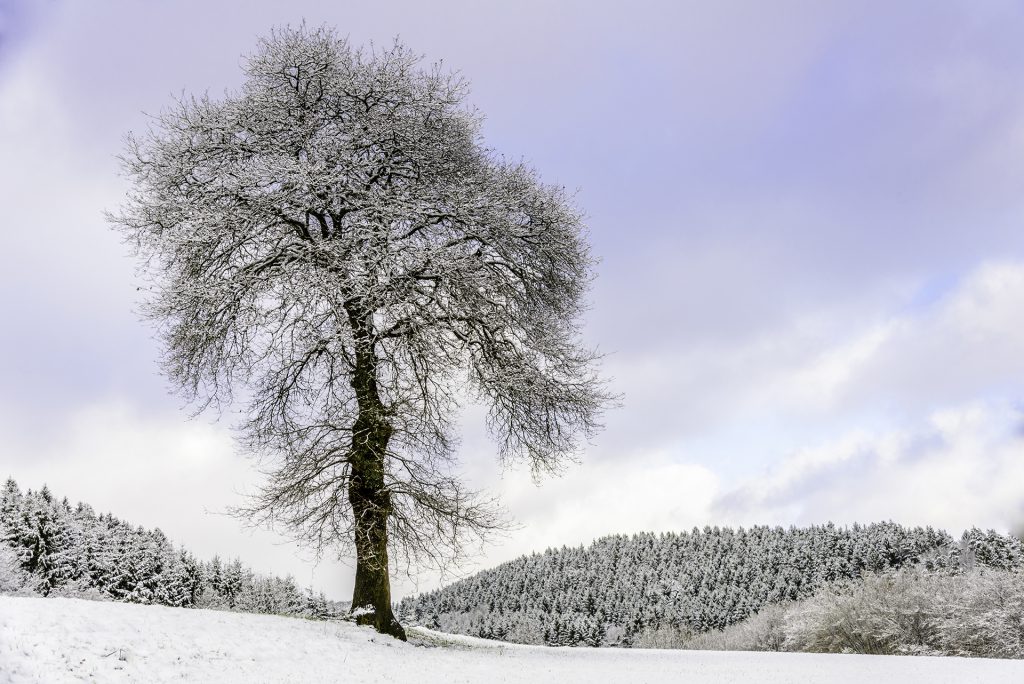
Tip # 1. Gear and more
Camera and lenses
The type or brand of your camera is not that important, and the number of lenses I will take with me will depend on whether I’ll be hiking and for how long. But a wide and long lens is always standard in my bag. I use a Nikon D810 and a Nikon Z_7_II for my landscape photography.
Whatever camera you use, take care of the transition between warm and cold and vice versa to avoid condensation and mould buildup over time. It can even cause the LCD to malfunction. Giving your camera time to acclimatise slowly indoors and outdoors would be best. This does not mean that you have to move in slow motion. However, one should allow the camera to adjust to the ambient temperature slowly by keeping the camera with a lens cover in a bag or cover for a while when moving into a warm area. It is best to leave your camera in the bag to warm up before taking it out. When you move from outside into the cold outside, keep the camera close to your body. Make sure that the temperature in your car is not too high while driving from your home to your photo destination, or store your camera bag in the car’s boot as far as possible from the heating.
If your camera might get wet because of rain or snow, bring it indoors and wrap it in a dry towel. Once again, let it in the towel for quite some time, letting the towel absorb all the moisture. Removing the battery and memory card before putting the camera in the bag or a towel is not a problem.
Investing in a good snow or rain cover might be a good idea if you go out during rain or snowstorms. It will keep your camera and lenses dry during the photoshoots, minimizing the chance of liquid residue getting close to the electronic parts of your camera. A plastic bag will work as well, of course. An umbrella is only useful when there is not too much wind. Moreover, your hands are full, so you must operate the camera with one hand. You could attach an umbrella to your tripod, but this would increase the risk of shocks and blurry photos. That is why I sometimes attach my umbrella to the straps of my backpack to keep my hands free. But if the wind gets too strong, the umbrella has to be closed again.
A lens hood can help protect your lens from the low sun and falling snowflakes or raindrops.
Batteries
You have probably already experienced batteries losing their power faster when exposed to low temperatures. Battery life will probably be less than 50% of what you are used to in normal conditions. Even when not in use, they will still lose their charge. Therefore, I advise keeping enough spare batteries warm in your pocket, close to your body heat.
Staying dry and warm
During winter, you must keep dry, protect yourself from the cold and wind, and wear the appropriate clothing. My secret is to wear different layers and, if necessary, thermal base layers. Synthetic fleeces or wool are a better option than cotton. As your extremities are susceptible to frostbite, do not forget a hat, warm socks, a scarf, and gloves.
Adjusting the camera buttons in low temperatures is always challenging during cold weather. The right pair of gloves can do wonders. I have to admit that I am still searching for the best results. If it’s not too cold, fingerless gloves can allow your fingertips to be free whilst keeping the rest of your hands warm. If not, you have to pull off your warm gloves on and off to manipulate your camera. Well-insulated and waterproof shoes or boots are also a must.

When the photographer gets wet, cold, or freezing and starts shivering, this can create a camera shake, resulting in unsharp photos. If you are out and your body can’t wait to get inside again, you are probably not in the right mindset to take pictures, regardless of how great the conditions are. So, these are all the more reasons to take good care of yourself.
Invest in ‘stability’
The light level is usually lower in wintertime, and days are much shorter. This means that the use of a stable tripod is sometimes inevitable. I keep repeating in my blogs that a good tripod is a worthy investment. Make sure to place it on stable ground. I use a Sirui W extreme series tripod for my snow hikes.
Pick a good camera bag.
The purpose of your camera bag or backpack is to carry your equipment, protect it from shocks and drops with the necessary padding, and protect it from rain or snow. That is why a good rain cover is critical. Backpacks can resist a few drops but not a downpour.
Extras
Have extra room in your bag for stuff such as heat warmers, fully charged phone snacks, drinks, etc. When you consider walking and setting up in the dark or near-dark, a small LED torch or even a head torch that operates completely hands-free can also be super helpful.
When photographing in cold weather, some snowflakes might find their way to your camera’s lens and disturb the view. Because your camera will be cold, the snowflakes will probably not melt and can be brushed or blown off with an air blower. These blowers sometimes come with a little brush. The brush, when dry and cold, can also be helpful.
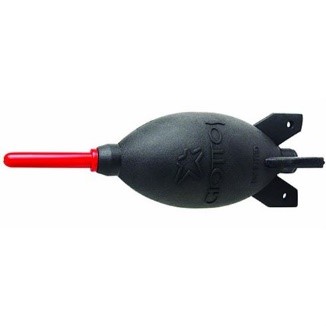
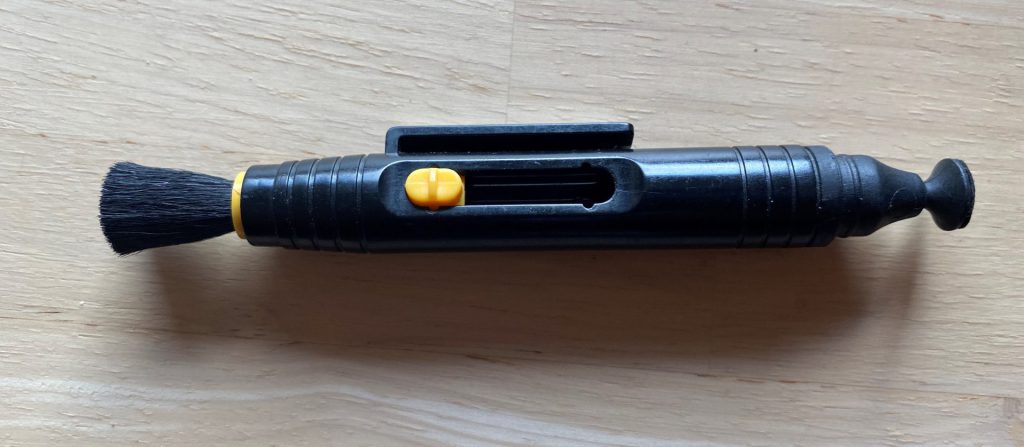
Do not brush them off with your hands because the warmth could melt the snowflakes and leave you with fingerprints or stains on your lens.
Tip # 2. Start with the weather forecast before leaving home
Before setting off for any winter photography adventure, you should always check the local forecast to ensure conditions are right and safe. Blue skies are lovely for creative moments in the snow, but even light snow can be fun to play around with. Even in the dullest and misty, icy conditions, there is always something possible for the brave photographer.
Additional reading on the weather can be found in my blog ‘weather and landscape photography‘
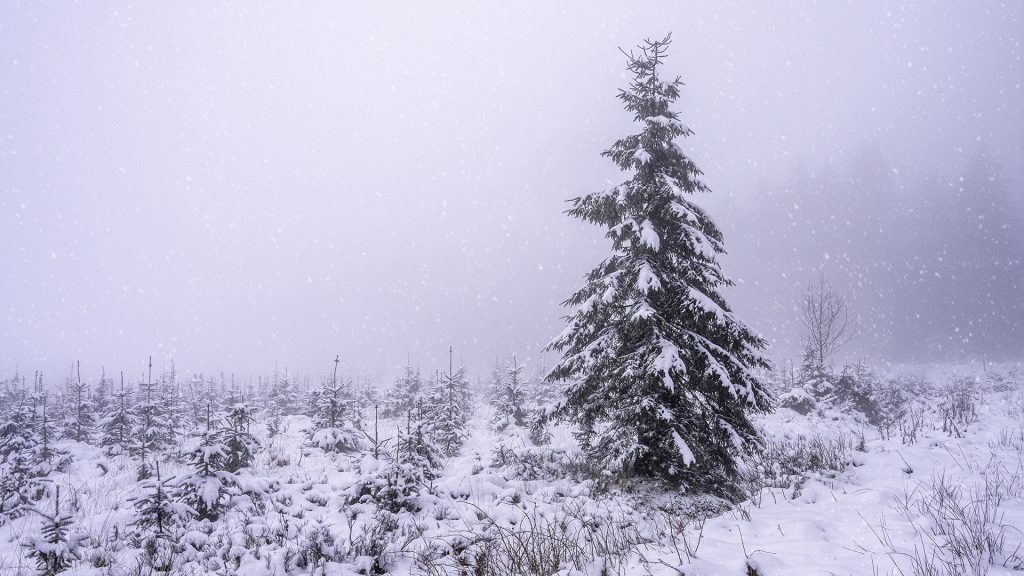
Remember that winter weather can always turn by the moment. So, bring extra layers, food, an emergency kit, etc., in case the weather turns for the worst. Don’t panic about a snowstorm before setting out. Just be safe and make smart decisions! Do not go out alone in a desolate area, or at least inform somebody where you are heading to and when you are supposed to be back.
Several tracking apps that use your phone’s GPS function are available. This can be very helpful for retrieving your car after turning around and losing directions.
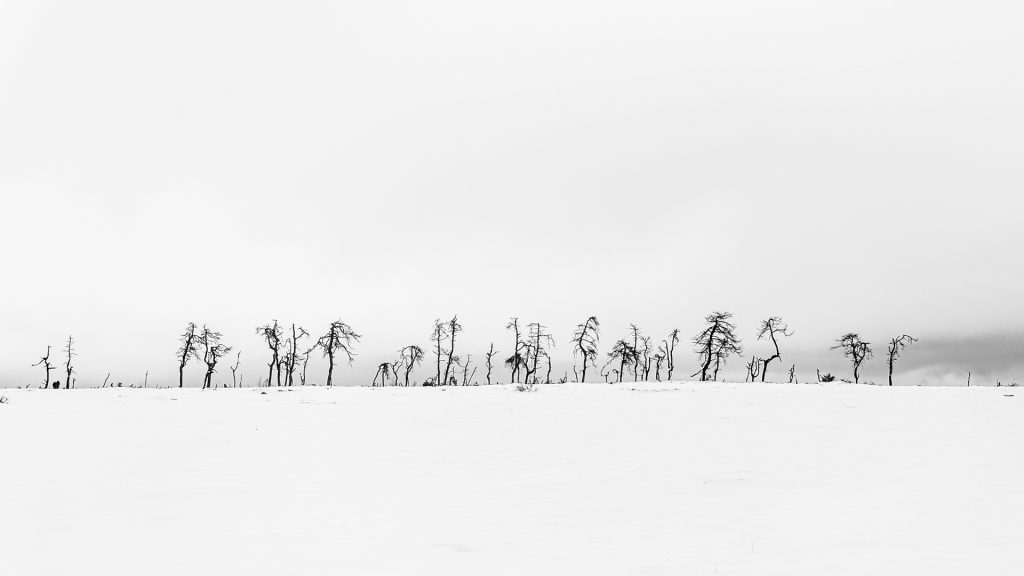
Tip # 3. Add scale by adding people
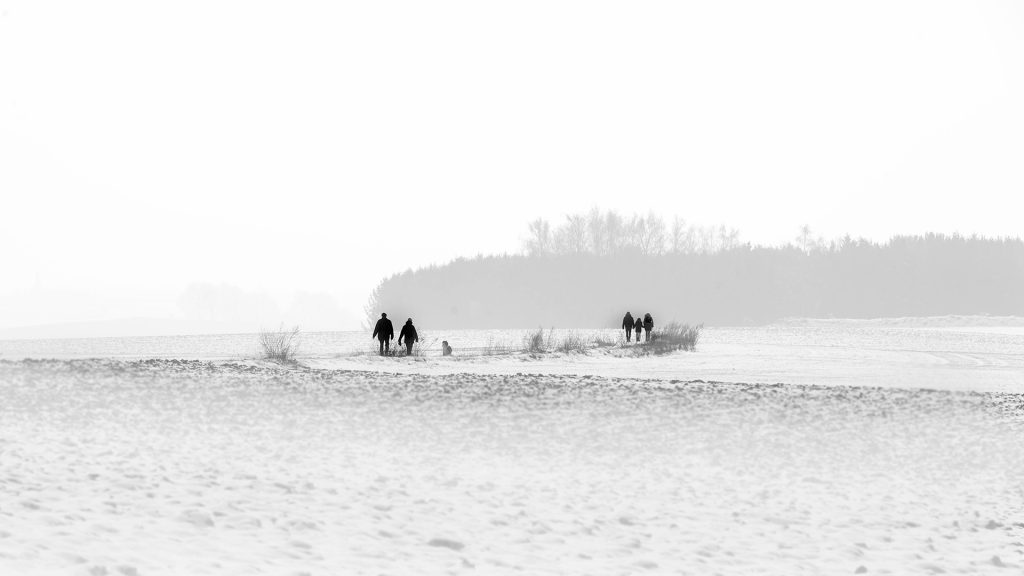
Like in any summer landscape, adding people into the shot can add a sense of place, scale, and interest. Does the person add value or detract from the winter scene? Does it give the viewer an idea of how large your mountains or trees are? If they don’t improve your overall composition, forget about it.
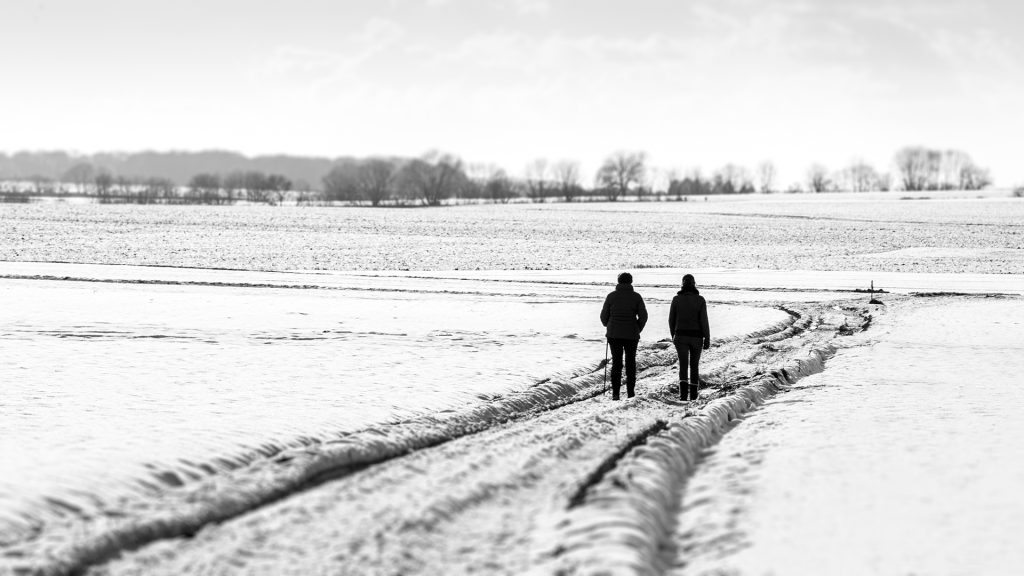
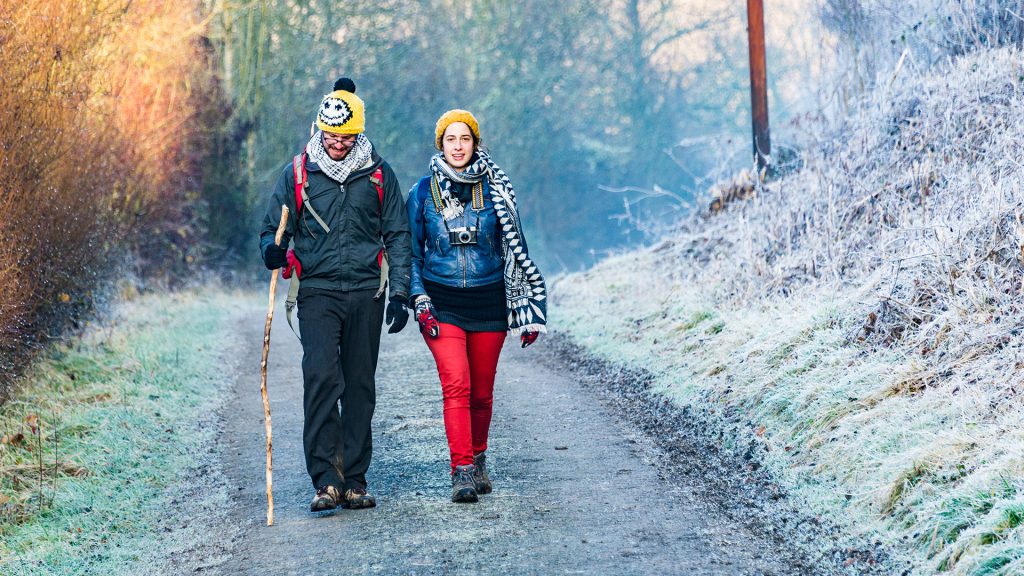
Tip # 4. Use Negative Space in your winter landscapes
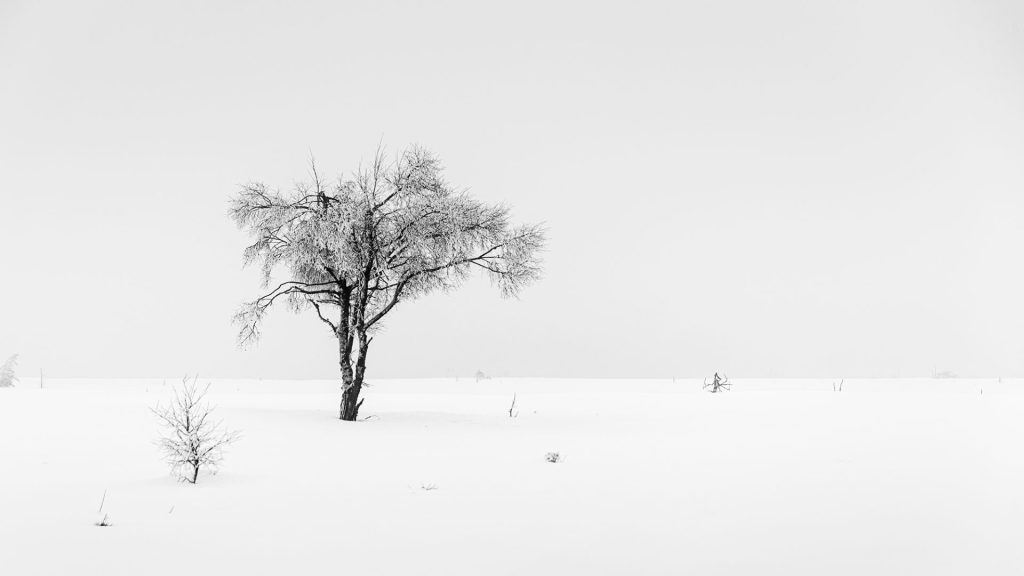
With abundant monochrome weather in the wintertime, using negative or empty space can often be striking. So, use the available white space to your advantage. When composing winter landscape photography, add a subject in the scene that adds depth to the photo. This can be a person, a tree, a rock, a building… Empty (negative) space can be minimalist and powerful.
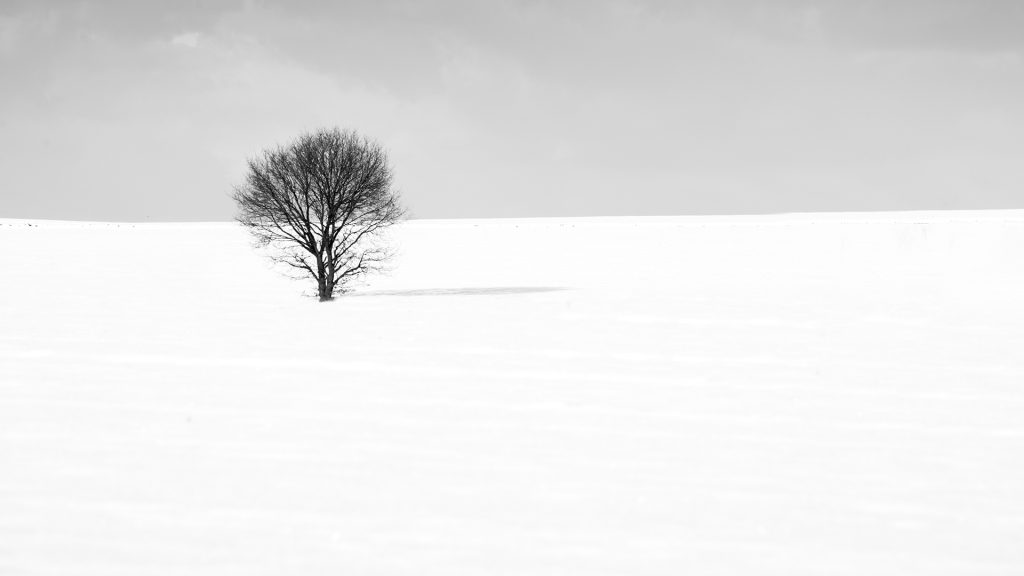
Tip # 5. Photograph during blue hour, sunrise, sunset…
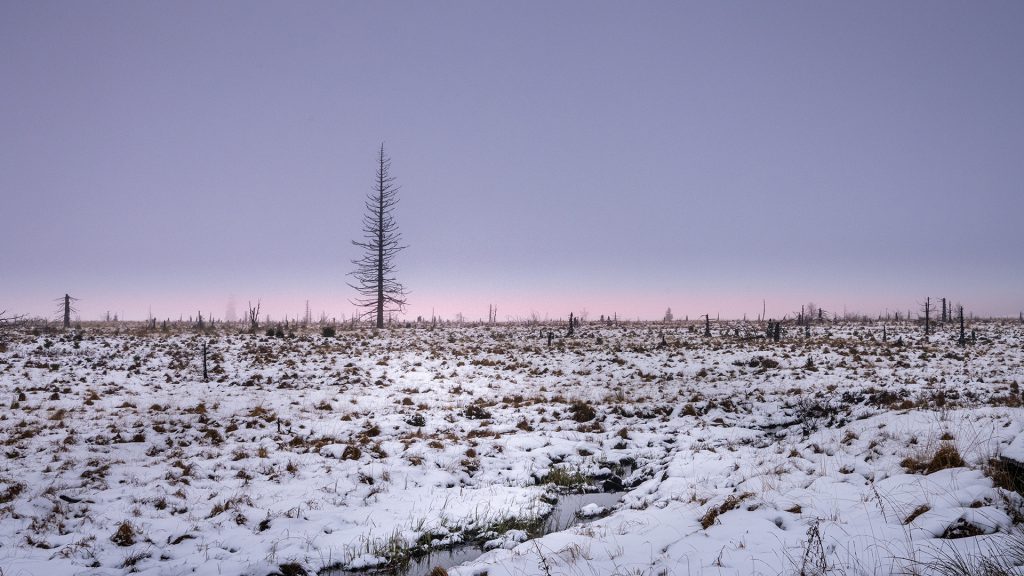
The blue hour is the period just before sunrise and just after sunset. The sun sets below the horizon, and the world turns blue. The light changes rapidly, lasting only 20-30 minutes. There is still enough light to shoot, although nothing is lit directly. This makes the light very soft. This makes sunrise and sunset a great time to capture photos of the mountains and other landscapes.
During wintertime, the sunrise and sunset can be much more dramatic than usual. For those like me who like to sleep longer, they are lucky that the sun rises much later in the day and sets much earlier.
Morning lights are usually colder than sunset lights. Probably the best combination is morning fog with the first signs of a sunny day. The first sunrays can brighten the whole scene and make the mist look glowing.
The whole point is to work with winter’s light, use it to your advantage, and capture beautiful winter scenes.
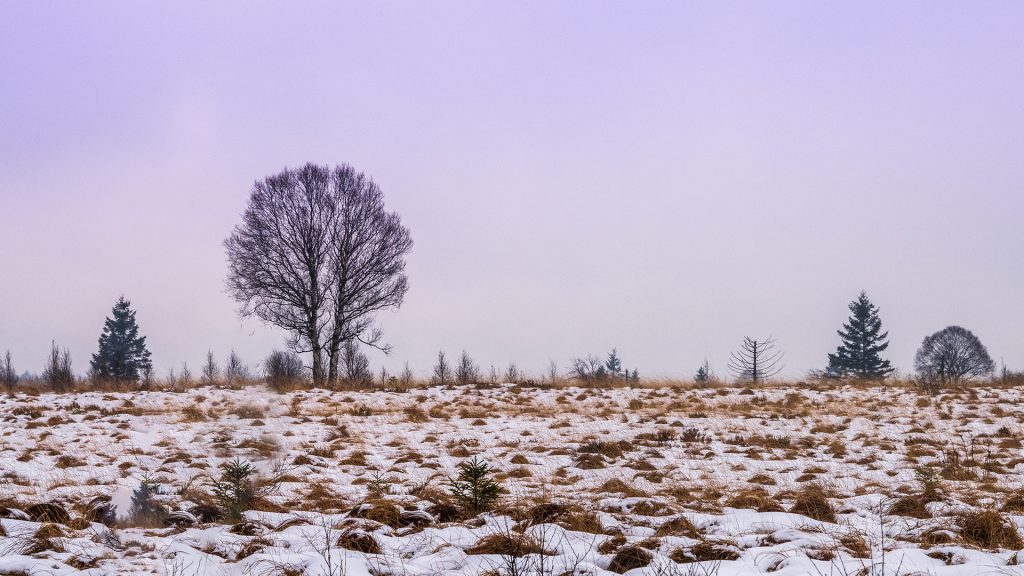
Tip # 6. What settings should you use for your winter landscapes?
One of the most challenging aspects of winter landscape photography is getting your settings right. Playing around with your camera’s exposure in the wintertime can be a good exercise in learning to know or understand your camera’s behaviour.
Relying on your camera set to auto-exposure can result in some disappointing, tonally grey or dull shots. The glare from the snow will confuse your camera, causing it to read the light in the scene wrong. It will see a lot of white, and I will try to tone this down. In many cases, you end up with underexposed and grey pictures. To avoid that, add positive compensation. That means adding around +1 stops or exposure value with your EV button or via the menu. (EV means exposure value) The exact amount will vary depending on the amount of snow and light. Make a test shot and check on the histogram to see if your exposure is correct. It is also useful to activate the highlights function to see whether or not the highlights are being blown out.
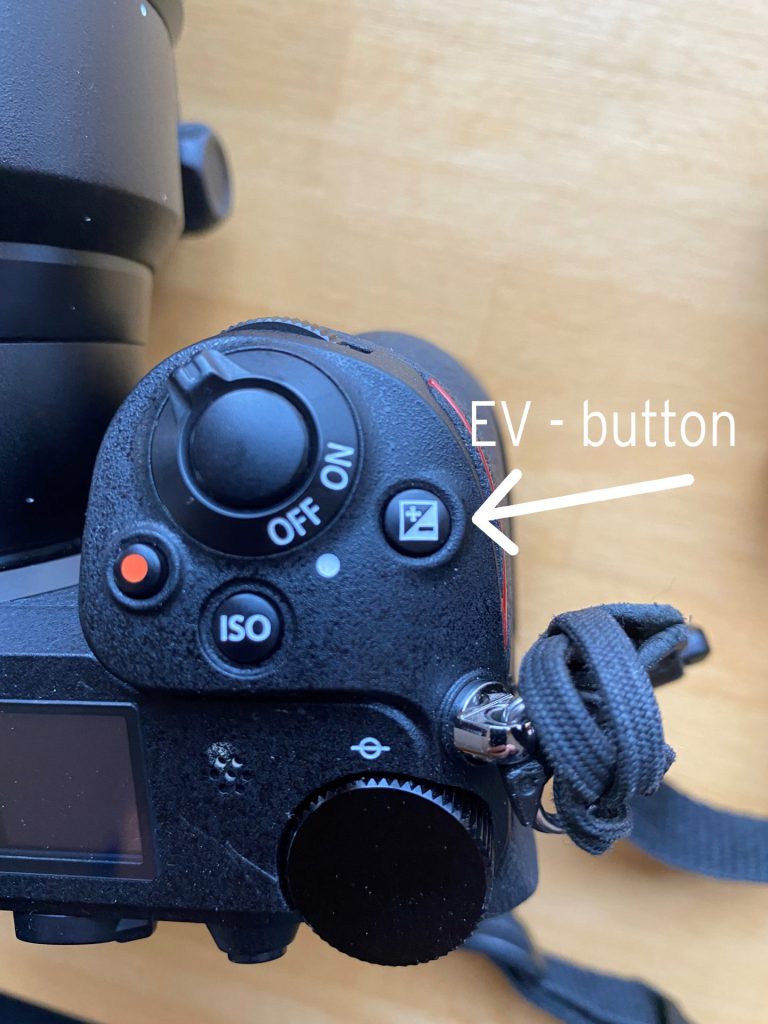
A winter landscape image can benefit from being a stop or two brighter. Just avoid clipping the highlights.
Choosing an ISO can be tricky. When you use an excessively high ISO, noise, especially in the shadow areas, could become an issue. I usually use an ISO as low as possible, although modern cameras deal much better with noise.
Your camera’s autofocus system can cause another problem when photographing snowy landscapes. If you focus on the grey sky or white snow surface, the system can work poorly or poorly because there is no detail or contrast. This leaves you with two options: either disable autofocus and focus manually or find a zone with detail and contrast and then apply focus lock (AF-L). After that, you point the camera back to your original composition and press the shutter button.
In my blog 14-tips-for-sharper-landscape-photos, you will find interesting tips to get tag sharp photos.
In my blog tips-for-the-novice-landscape-photographer, you will find more general information on compositions and camera settings.
Tip # 7. Setting the white balance for better snow landscape photography
It is possible to choose your white balance in the camera or to adapt it in post-processing when you shoot in RAW. Both options work well. If you only shoot jpegs, you have less room for manoeuvre in post-processing, and it has to be more accurate in-camera.
You will agree that winter is cold, so a beautifully” cold white balance” looks best. Please do not overdo it; otherwise, you will have a completely blue image. Experiment, see what you get and decide what looks best.
When you shoot in RAW, you can automatically leave the white balance on and use the temperature slider in Lightroom or Photoshop to switch between warm and cool effects.
Tip # 8. Act fast
Snow comes and goes. That means it can blow in fast and melt just as quickly. Trees with thick snow can become drabby in an instant. Big drops can fall into your neck or onto your camera and lens. One of the most essential winter photography tips is to act fast when snow is fresh and not wait too long. So, you can get the shots you deserve for being out there. And avoid all trampled scenes because of the many walkers.
Just be patient with the sun. Sometimes, the sun can go behind a cloud, drastically changing your light metering. Wait and experiment with natural lighting once the sun comes back out.
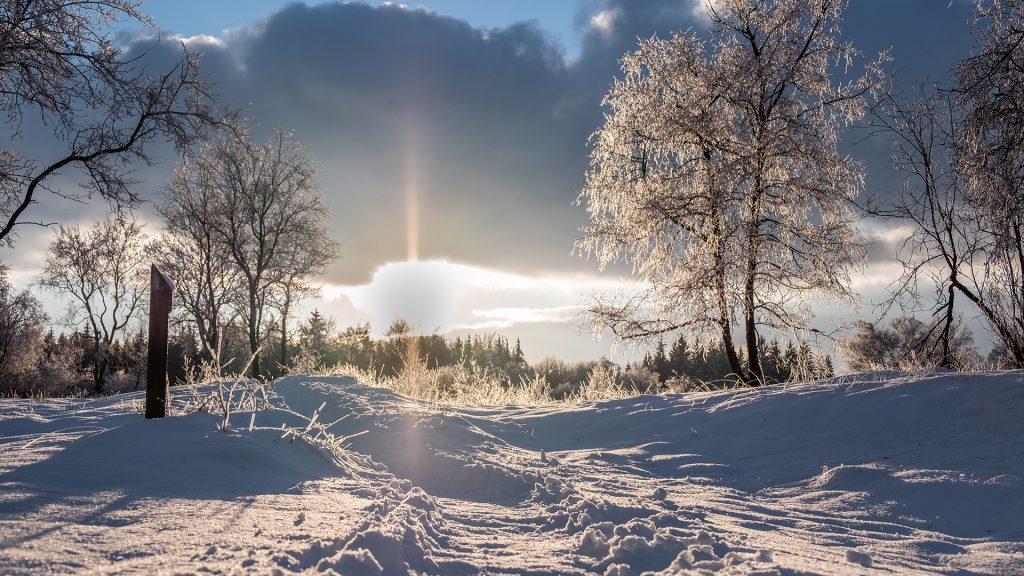
Tip # 9. Play With Perspective
In your winter landscape, you will find several natural elements that can be shot in various ways and used as lead-in lines or focal points. That means you have plenty of opportunities to explore perspective. When shooting low, you can add a blurry foreground and include some snow very close to the lens.
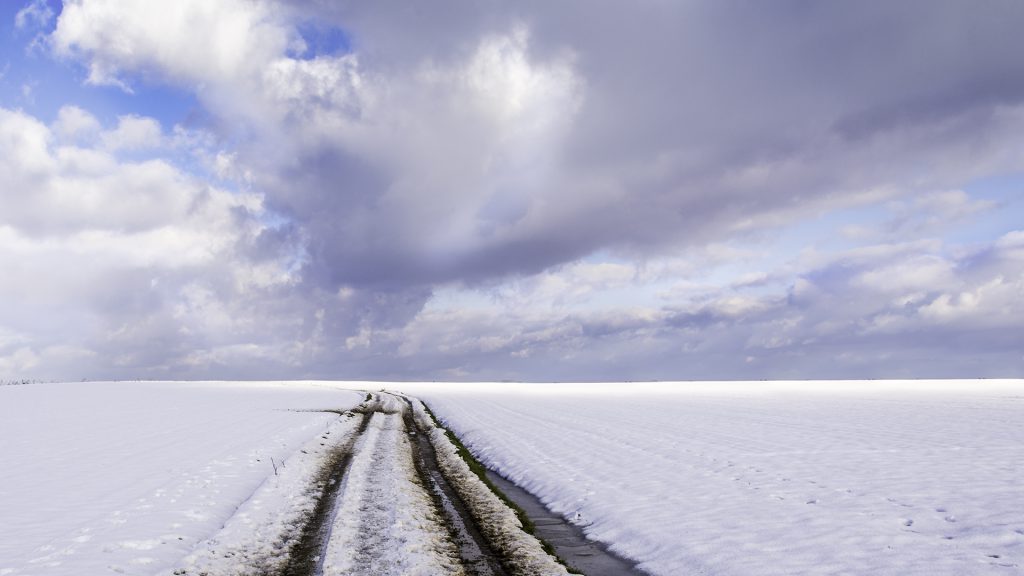
Those who are into drone photography can find theatrical and beautiful views from a higher perspective.
As in other seasons, the rules of composition remain an important tool for creating a pleasing image.
Tip # 10. Capture the falling snow
Including the falling snowflakes in your compositions can be a great way to enhance your winter shots. When capturing that, consider using a telephoto lens and shooting at a shallow aperture (consider f/4.5-6.3). Set up the fastest shutter speed (1/400 of a second or faster) if you hope to freeze the action. Large and slightly blurred snowflakes in front and behind your subject will create that unique feel. To photograph gently blurred streaks of snow, use a tripod and a long exposure to slow the snowflakes down.
Tip # 11. Use winter fog in your landscape photos
Winter photography tips are not just about snow. Glistening snow is undoubtedly beautiful, but snow and fog are an even better combination—white powder on the fields and trees and greyish-white haze in the sky above. Nature could not look more mystical.
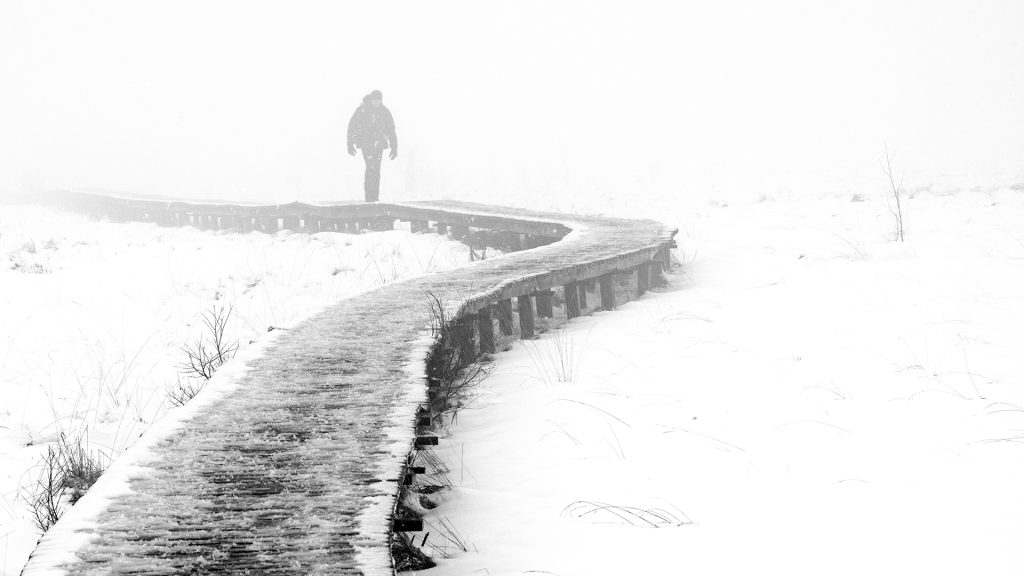
For example, you can use winter fog as a mysterious background. It enhances the lonely and cold side of winter. Fog or mist can make disturbing background elements invisible and simplify the photo to your advantage.
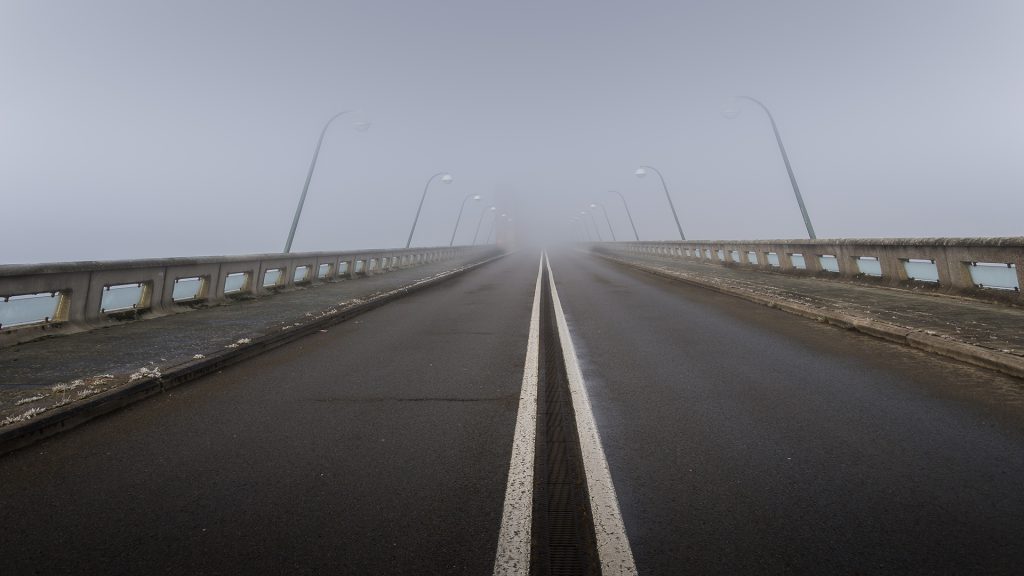
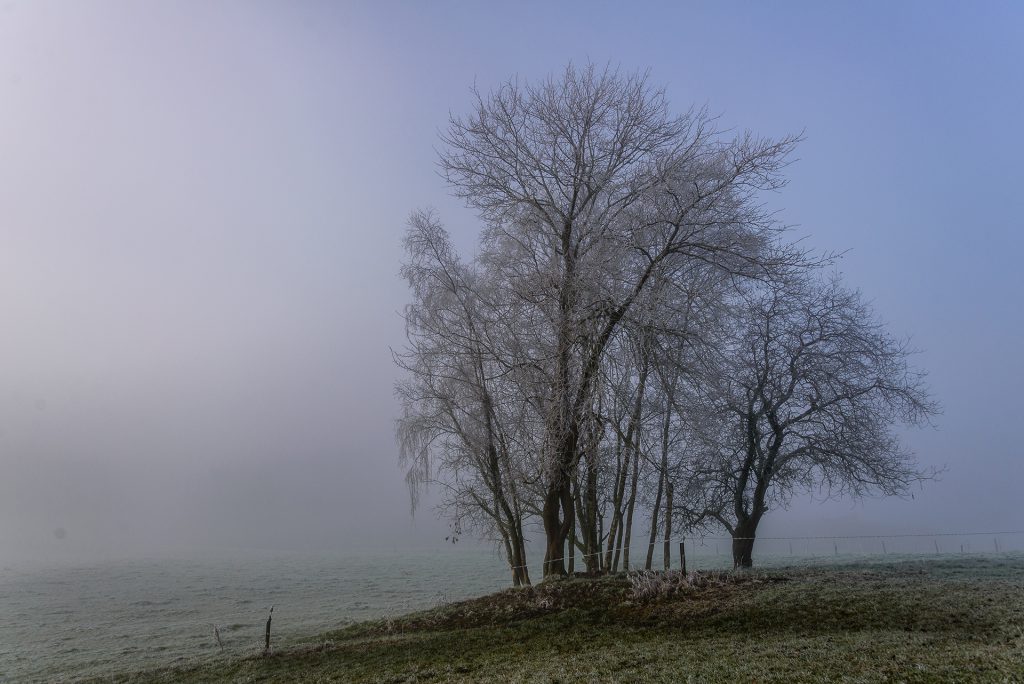
Tip # 12. Take macro photos to capture winter in detail
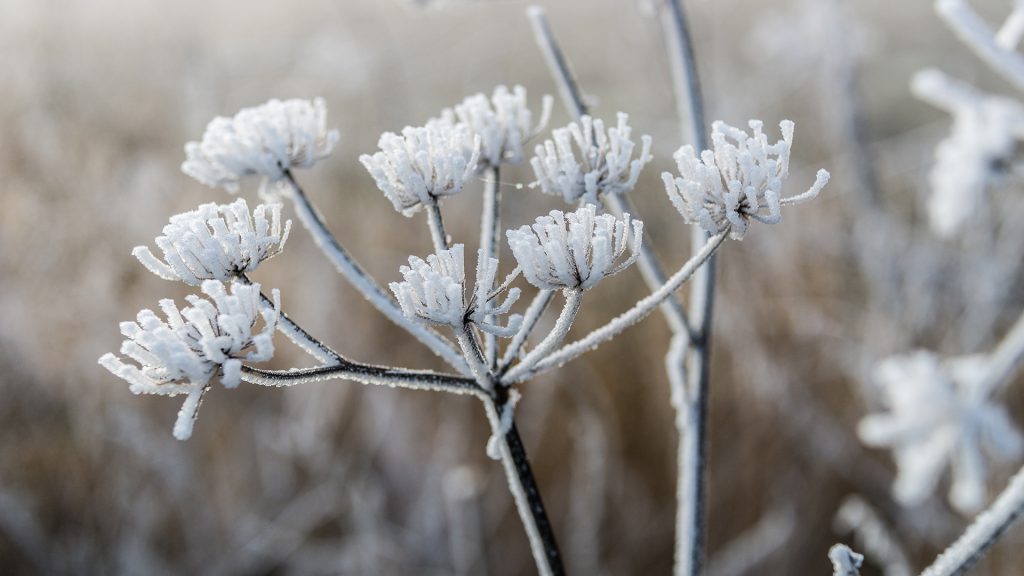
Details of frosted flowers on a cold, misty winter day, Guy, 2016.
In landscape photography, you do not have to use wider vistas to capture winter. A very creative way is to focus on the beauty of winter by looking at details. One of the best ways to do that is to photograph snowflakes or frost in nature. If you want to get close, you should take your macro lens. But there are also plenty of details to be captured with other lenses.
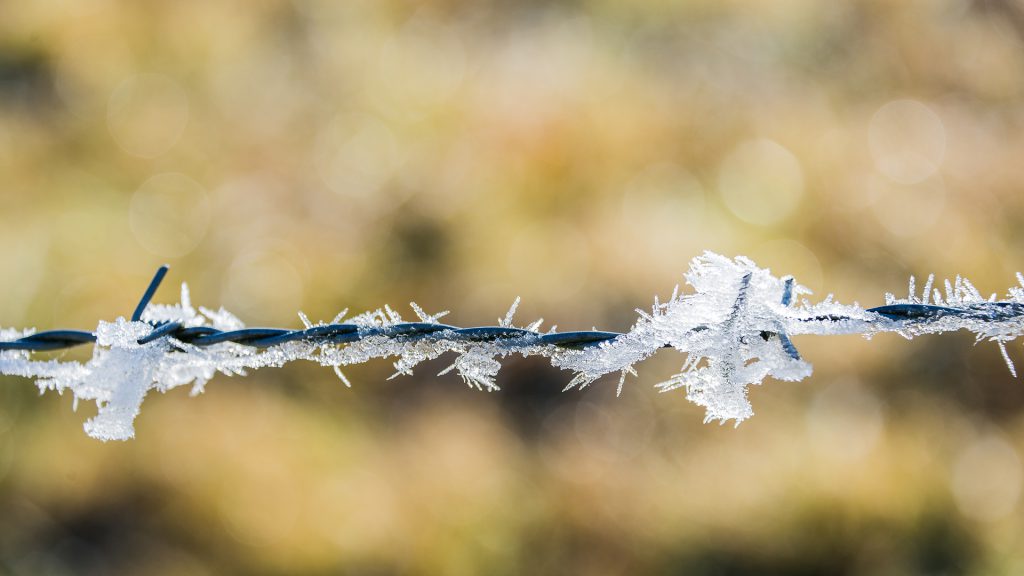
The ice crystals on this barbed wire enhance the barbed wire effect, and the sun coming from behind creates a bokeh effect in the background, Guy, 2016.
Frost can be found anywhere and always looks stunning. Combined with sunshine, it can result in breathtaking photographs.
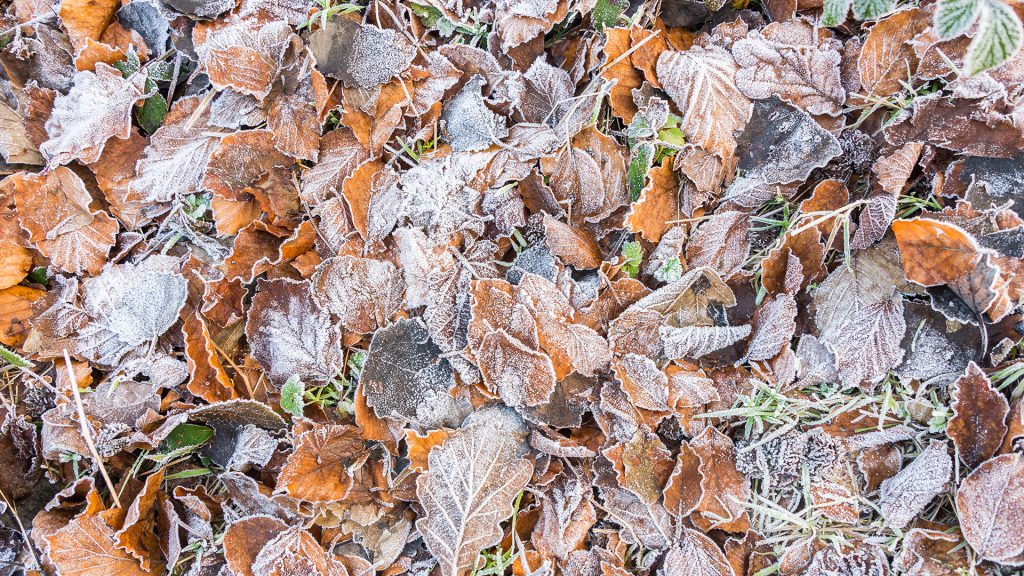
Focusing on details or structures with a longer lens will also give exciting views.
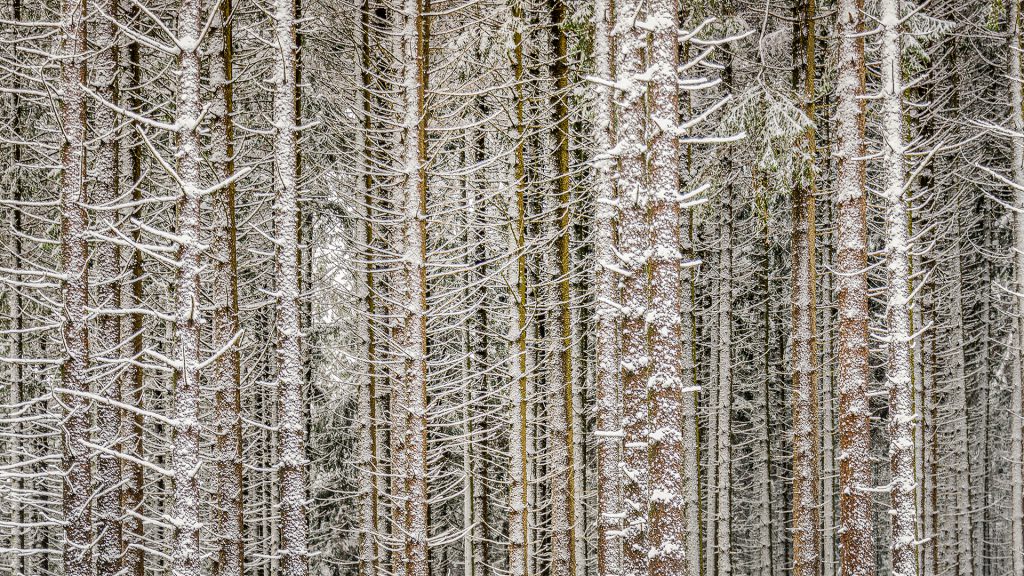
A closer look at stems of pine trees covered with snow offers an exciting pattern., Guy, 2017.
Tip # 13. Look for contrast
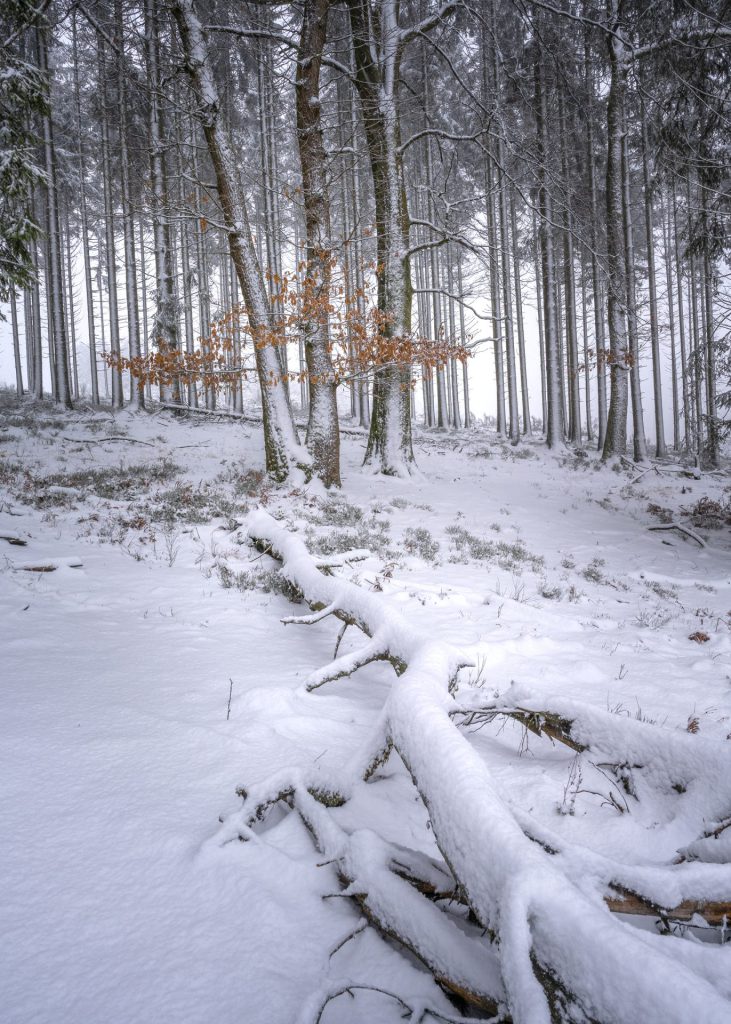
In white winter landscapes, any little colour can stand out and make a photo remarkable. Consider using a colourful jacket or umbrella in a snowstorm to contrast an otherwise overcast photo. When the landscape is entirely white—white trees, lakes, mountains, and (usually) a white sky—finding a compositional focal point can become challenging, as nothing catches the eye.
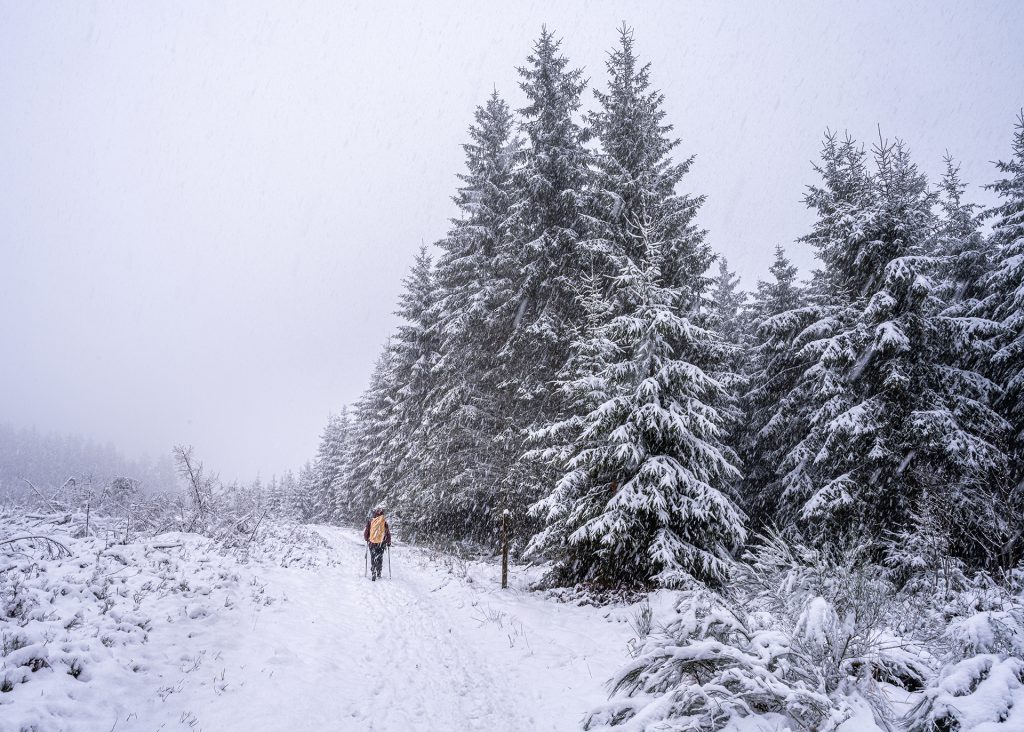
The trick is to look for contrast. This can be colour contrast, where you find a splash of red, blue, or green against the white background. But it can also be a tonal contrast, such as a splash of darkness against the bright snow, like a darker tree against a white backdrop. So, look for something that stands out from the white blanket.
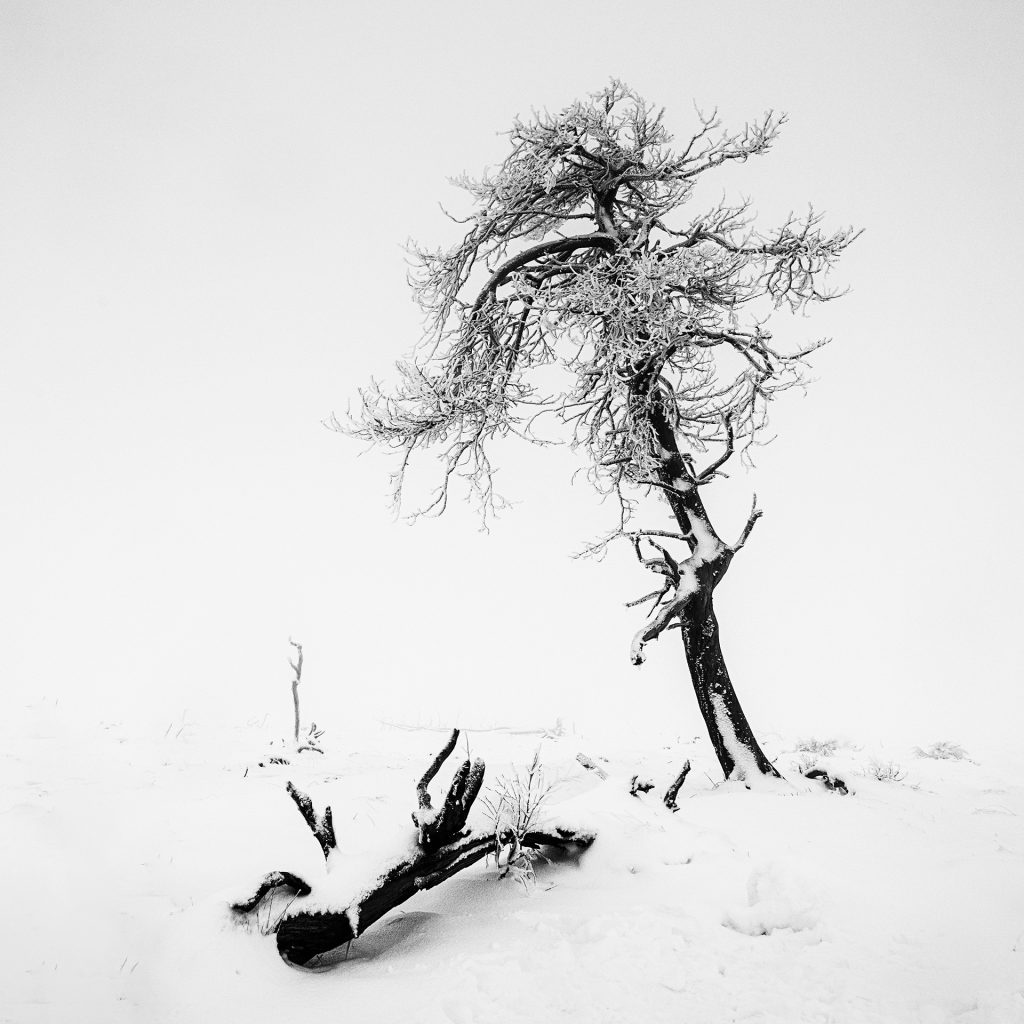
Without a focal point, the viewer’s eyes would have no resting place, making the shot bad.
Luckily, contrast is relatively easy to find on snowy days because it will catch your eye as it will a photo viewer’s eye.
Perhaps there’s an autumn leaf lying on top of a thin layer of snow, or maybe it’s a few skiers or hikers wearing red jackets or a dark mountain or rock surrounded by white. Find a dominant colour or dark tone in the otherwise white landscape, then use the usual composition techniques (rule of thirds, leading lines, etc.) to make it a better picture.
Tip # 14. The use of filters
I use fewer filters in winter photography than in other seasons, yet I usually take grey gradient filters when the dynamic range gets too wide. This could happen if you want to shoot the sunset and the sky is still very bright.
A polarizing filter helps dampen reflections on snow or thawing water. It also produces more intense colours, such as in the sky, if it is blue.
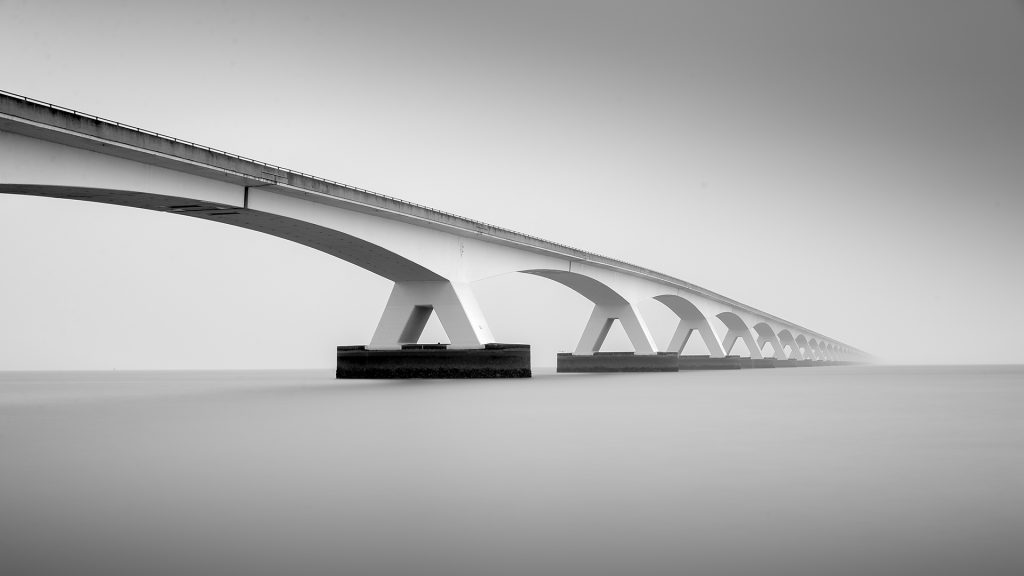
In my 3-part blog on the use of filters, you will find more information about filters: part 1, part 2, part 3
Tip # 15. Black and white winter landscape photography
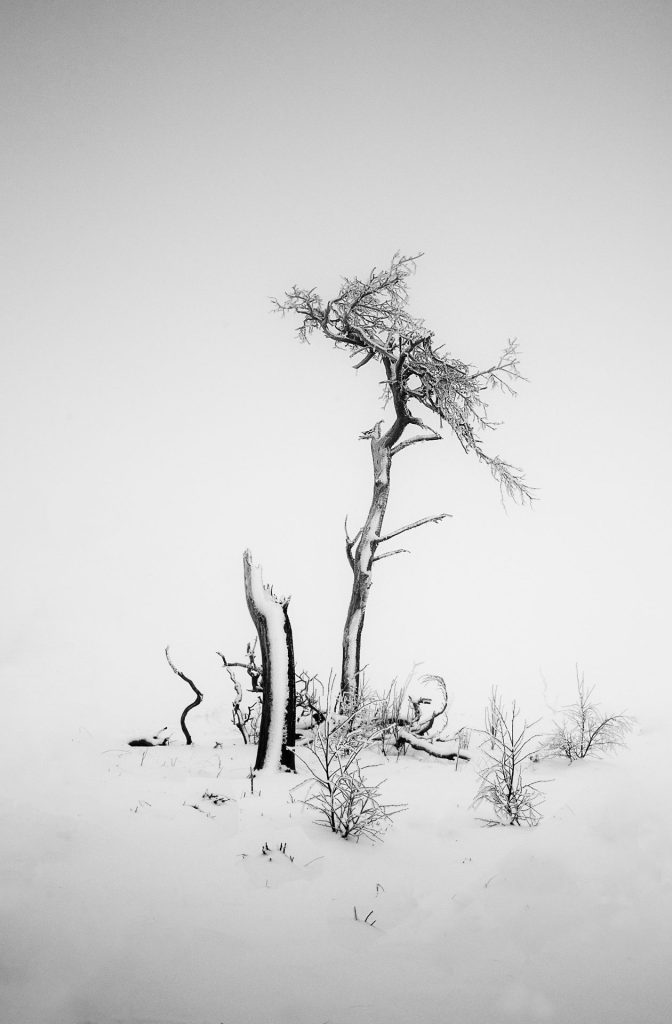
In winter landscapes, there is usually less colour present. So why not turn your pictures to black and white in post-processing to create minimalistic landscapes?
Please look at my black and white photography blog: the art of black-white landscape photography.
Additional reading material can be found in my blog on fine-art-landscape-photography as well as in minimalism-in-landscape-photography
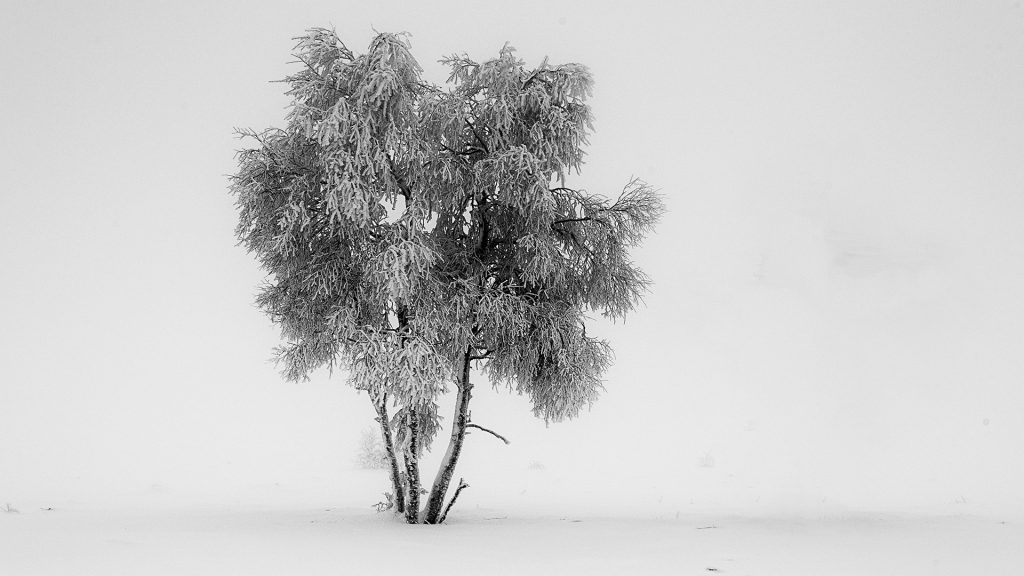
Tip # 16. Be creative and create a portfolio or series of photos
By a portfolio, I mean a coherent whole of several images. The coherence can be expressed through style or story. A possible approach could be a reportage about your favourite nature reserve or a particular species or a subject, all images with the same characteristic, etc.
In the example below, I have put together six photos taken on the same day in the same area in East Belgium (Baraque Michel). It was freezing; there was fresh snow and much mist. It was not much fun for the photographer, but it resulted in an excellent minimalist series of six images that credit the trees. Because of the fog, little of the background is visible, simplifying the image. The image was converted to black and white in post-processing, and the contrast slightly increased with the help of luminance masks in Photoshop because the fog blurred everything a bit.
Several forest fires devastated the forest more than once, and young birch trees tried to pioneer the area again. The fierce climatic conditions, however, make it difficult for them to survive age, weather, fire and human interference. Nevertheless, even the damaged trees, with broken wings (branches), express great appeal to the eyes. Standing tall in the snow and the mist or even lying down, they look like pen drawings, with graphic simplicity and beauty. Throughout the series of photos, you can also see the evolution of a proud standing tree to a wholly broken trunk lying in a bed of snow.
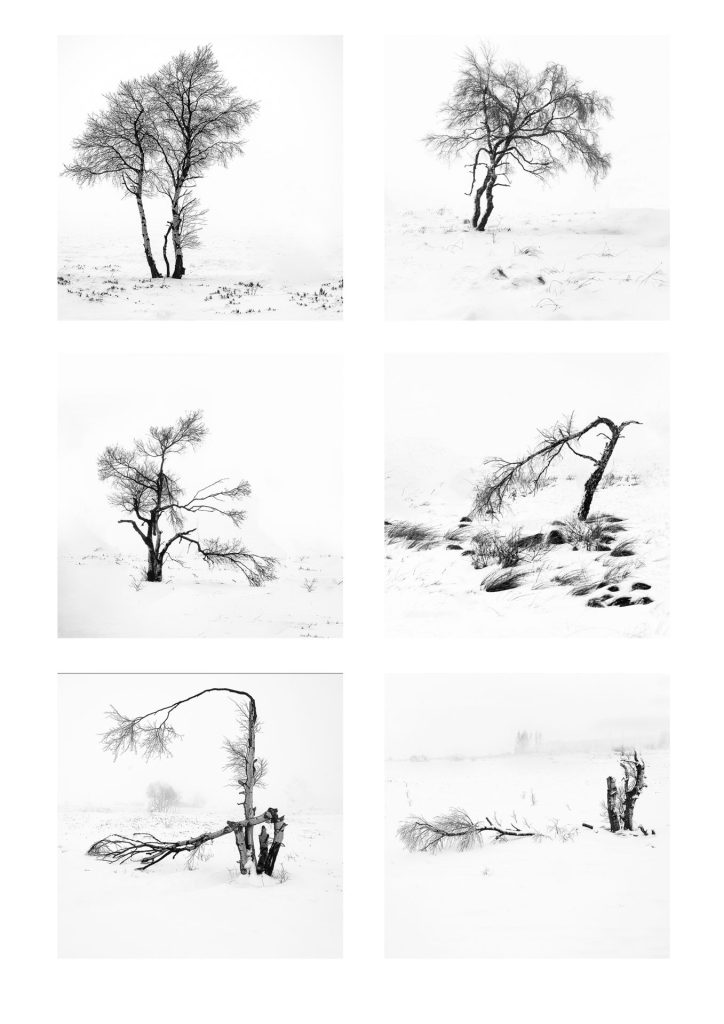
Another possibility is to revisit the same scene in different seasons:
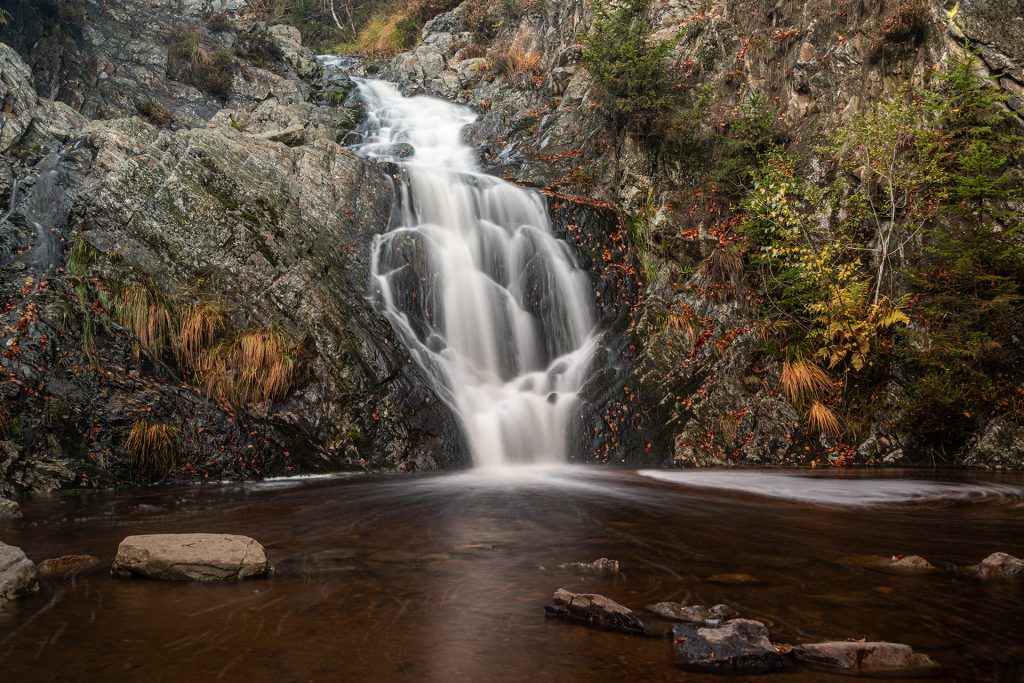
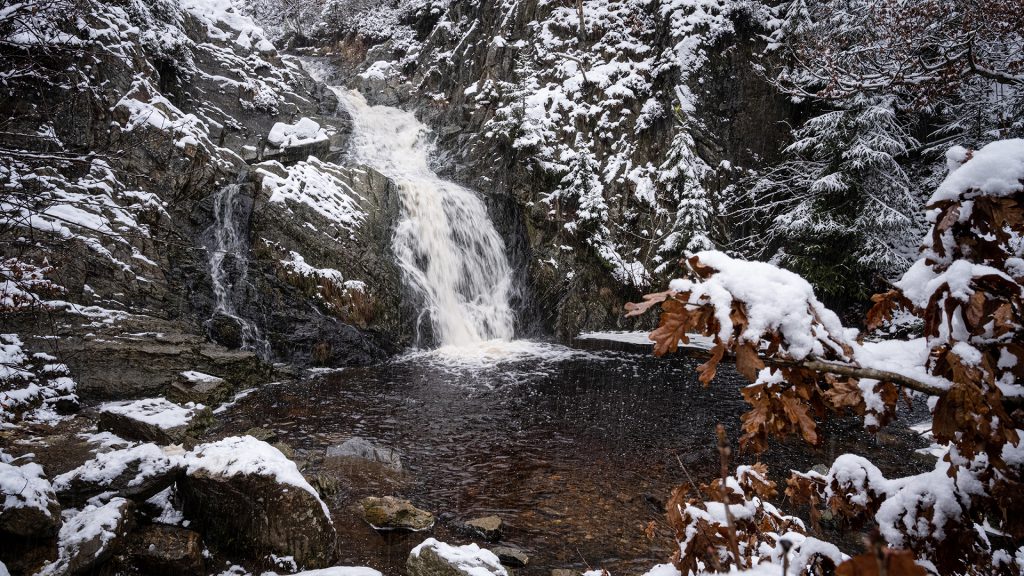
In the four photos below, you see the same landscape from the same perspective in the four seasons.
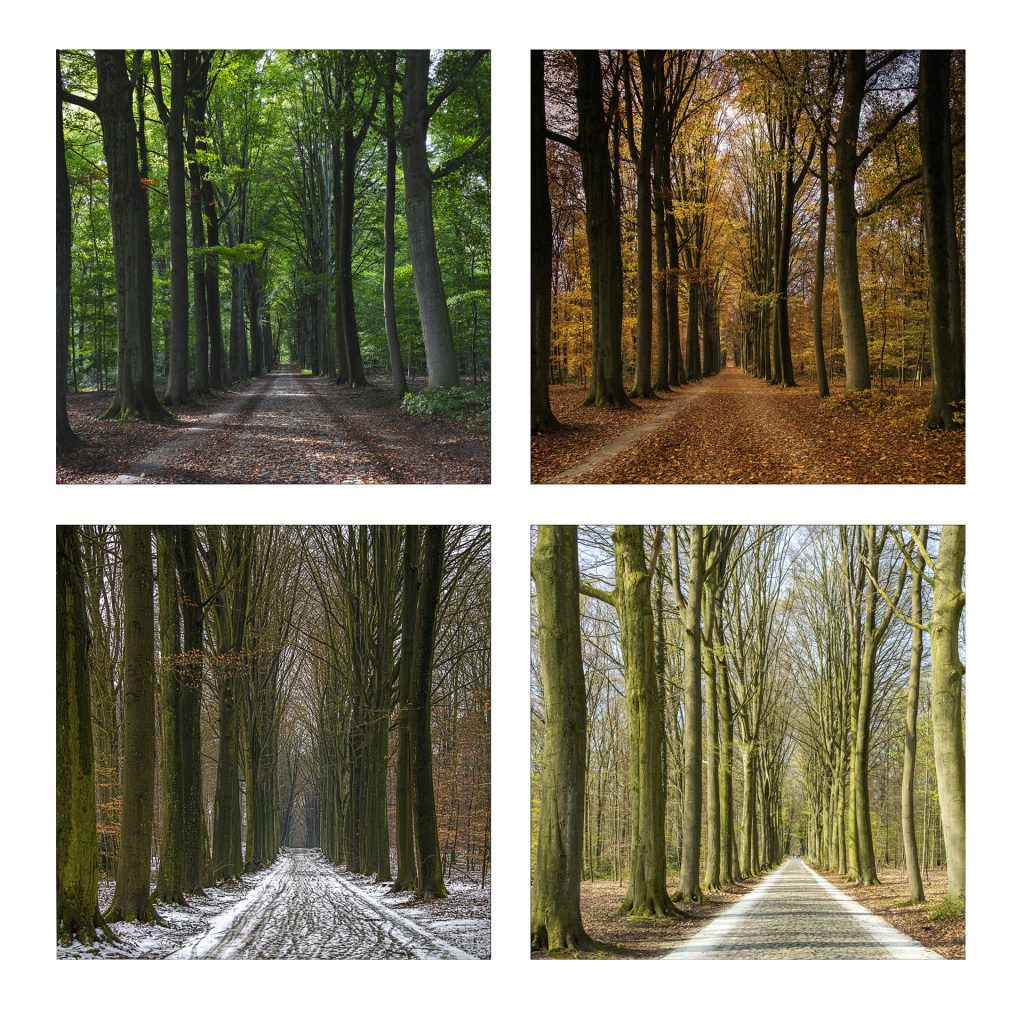
Another creative idea might be to experiment with intentional camera movement. In forest areas, this will mostly mean you choose a longer exposure and move your camera upwards in line with the tree trunks while pressing the shutter button.
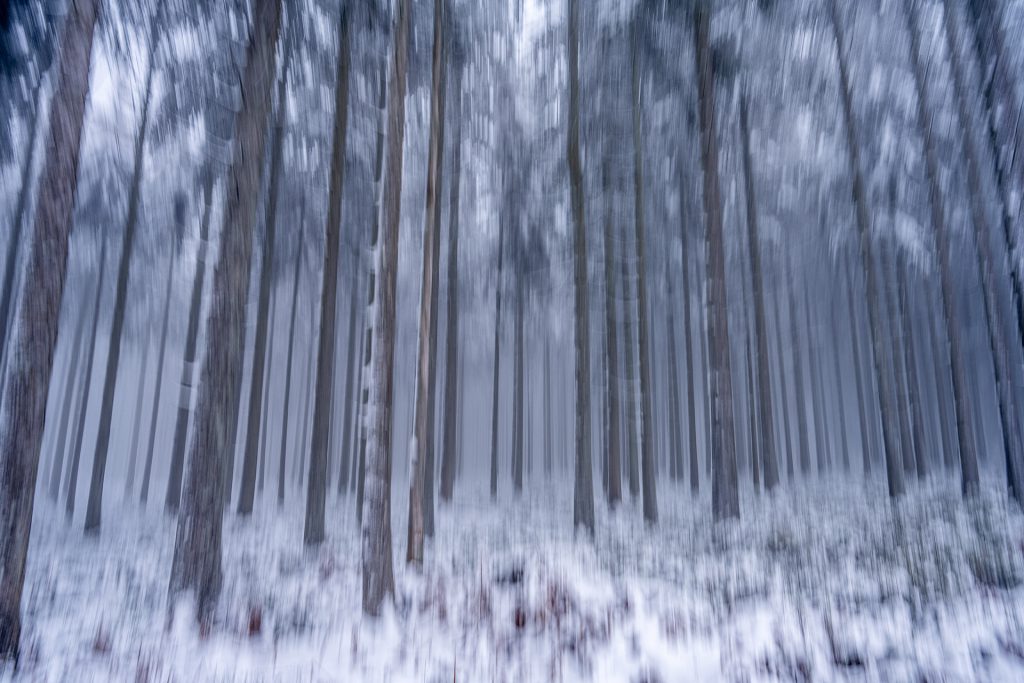
Tip # 17. Post-processing
As mentioned, the most important thing to do in post-processing is to set the white balance correctly to avoid unnatural colour casts, set white and black points and adjust some contrast. I use both Lightroom and Photoshop plus plugins like Silver-efex-pro (nik collection dxo), BW-artisan-pro-X-2022_panel
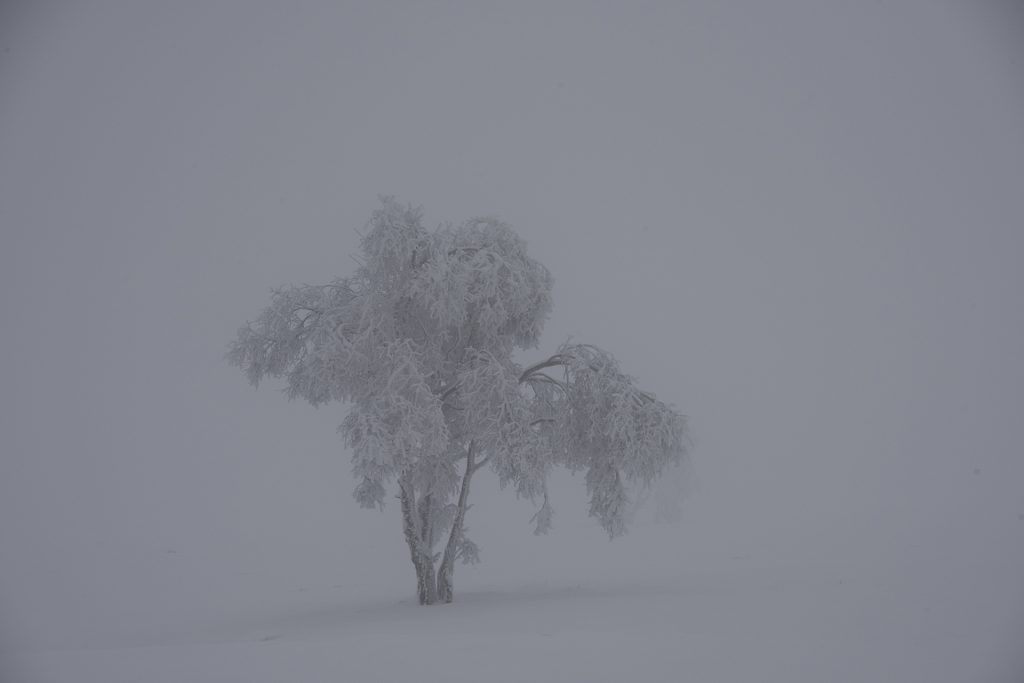
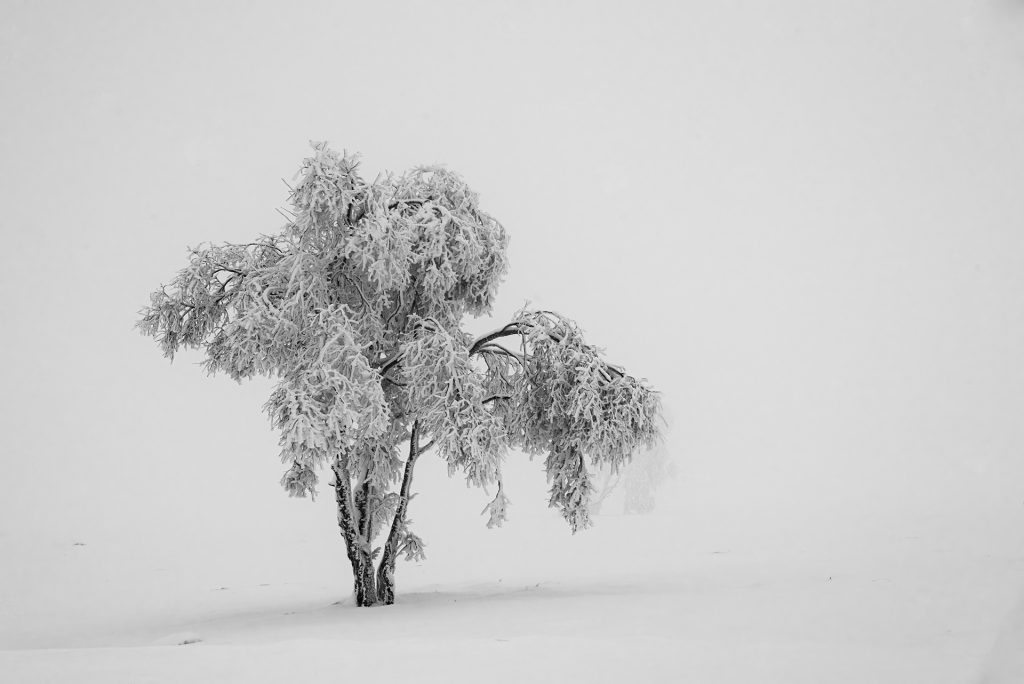
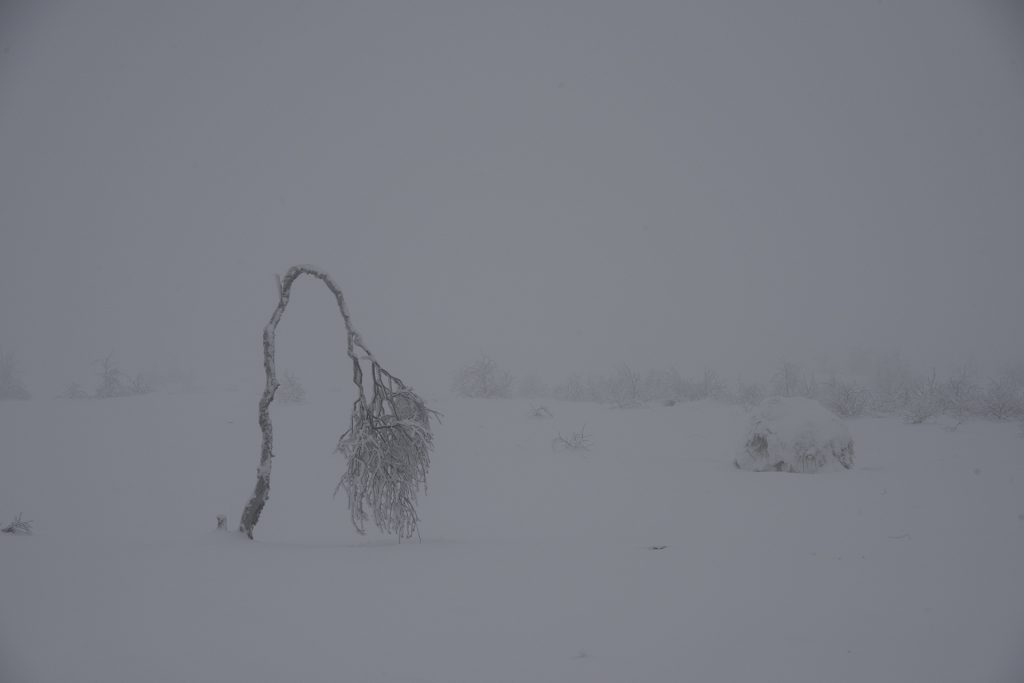
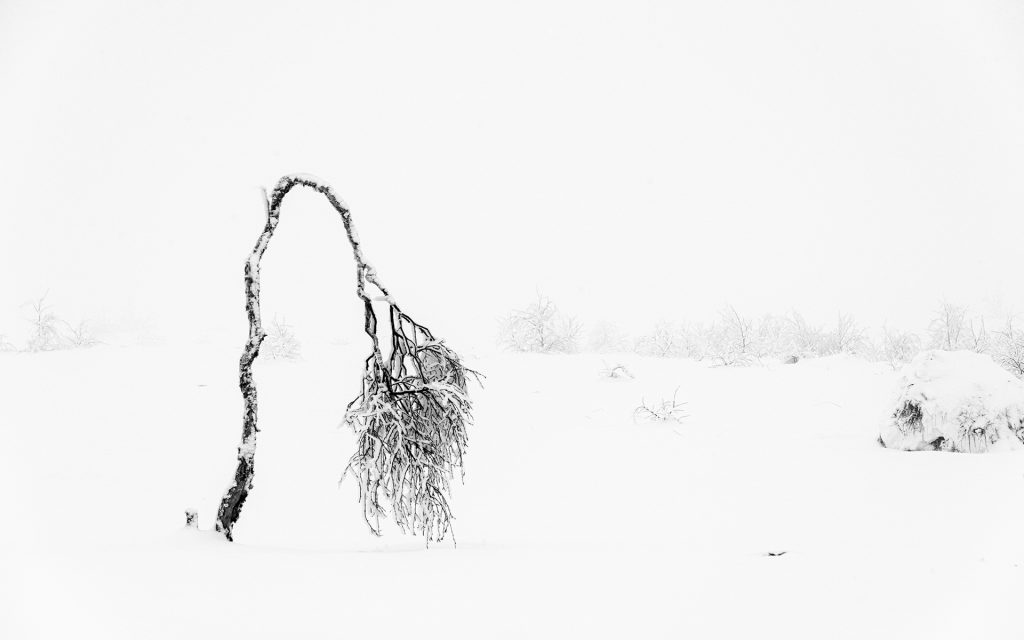
Conclusions about our Winter Landscape Photography Tips
Winter is coming or already here. I hope I have convinced you to go out in winter with your camera.
Please take some of our winter landscape photography tips and experiment with them to get outstanding images.
Please leave a comment or question here below.
Leave a reply